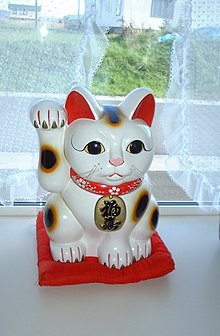Ōban
Appearance
You can help expand this article with text translated from the corresponding article in Japanese. (October 2024) Click [show] for important translation instructions.
|


An Ōban (大判) was a monetary ovoid gold plate, and the largest denomination of Tokugawa coinage. Tokugawa coinage worked according to a triple monetary standard, using gold, silver and bronze coins, each with their own denominations.[1]

The first Oban – Tenshō Ōban (天正大判) – were minted by the Gotō family under the orders of Hideyoshi in 1588.[2]
The Tenshō Ōban was equivalent to ten Ryōs, or ten Koban (小判) plates, with a weight of 165 g.
Notes
[edit]References
[edit]- Mark Metzler (2006). Lever of empire: the international gold standard and the crisis of liberalism in prewar Japan. Vol. 17 of Twentieth Century Japan: The Emergence of a World Power. University of California Press. ISBN 0-520-24420-6.

